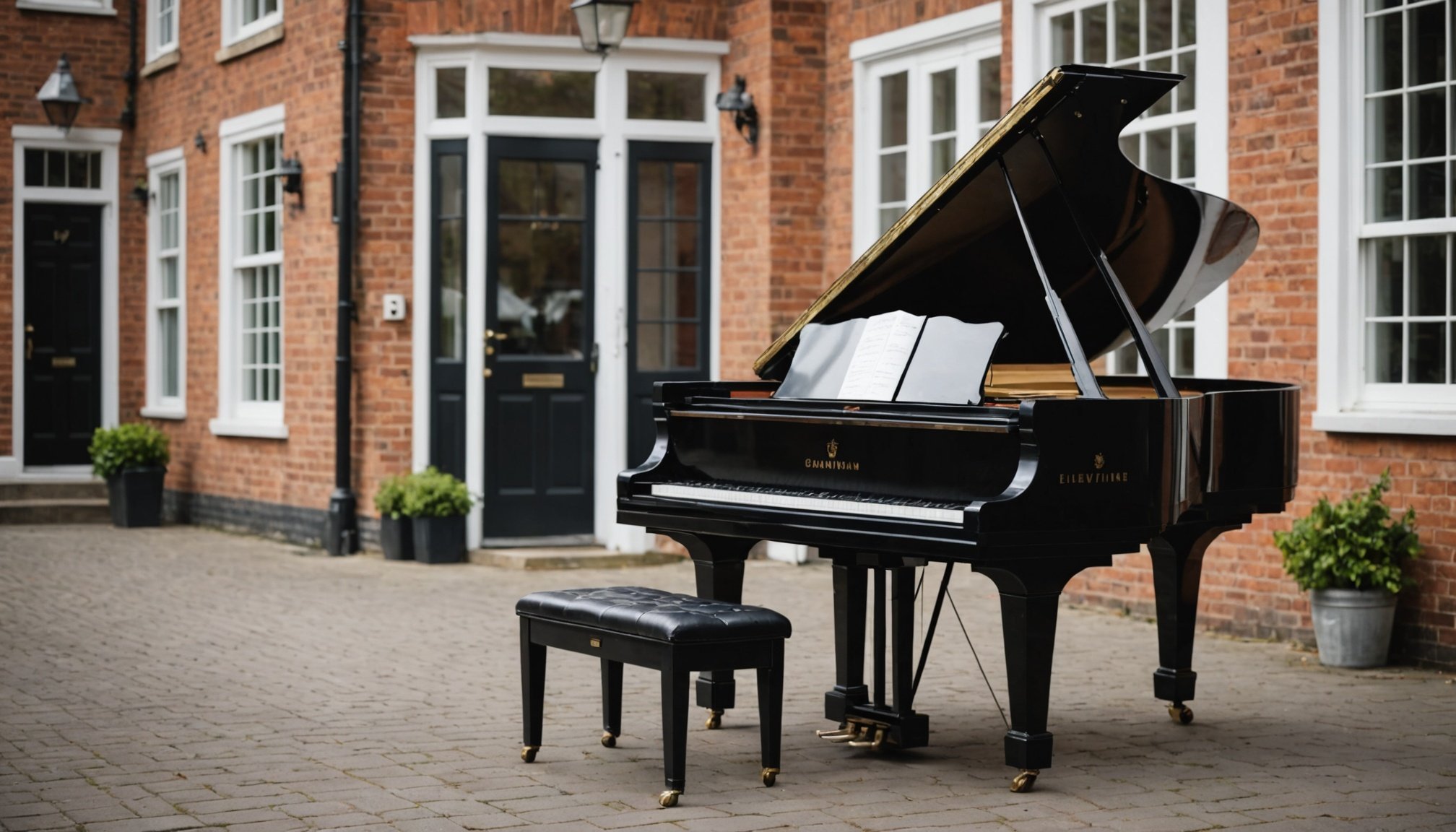Understanding the Challenges of Moving a Grand Piano
Navigating the complex structure and significant weight of a grand piano poses unique challenges. Typically, these instruments can weigh between 500 to 1,200 pounds, making them cumbersome to handle. The grand piano’s elegant but bulky shape requires precise manoeuvring to ensure safe handling and transport.
Common obstacles faced during piano relocation include narrow doorways, tight hallways, and staircases, which can easily cause damage if not navigated with care. Additionally, the intricate components of the piano, like its strings and hammers, are susceptible to mishandling.
Have you seen this : Top tips for mastering the Portugal NHR program
Engaging professional help is crucial in overcoming the moving difficulties inherent in transporting such a piano. Professionals possess the expertise required to disassemble, transport, and reassemble the piano without causing harm to its delicate parts. They utilise tools specifically designed for piano moving challenges, ensuring that relocation considerations, such as securing the instrument during transit, are managed with precision.
The lack of professional expertise during relocation can lead to substantial repair costs and potential depreciation of the piano’s value. Therefore, piano relocation considerations should always factor in the hiring of skilled movers to facilitate a smooth transition.
Topic to read : Navigating the portugal nhr program: a complete guide
Planning Your Piano Move
To navigate a successful piano move, meticulous planning is essential. Start by creating an inventory of your piano’s features, noting any unique elements that require special care. Assess both your current home’s layout and the new space, focusing on dimensions and potential obstacles, such as doorways and staircases, to ensure a seamless transition.
Develop a clear timeline for your move, ideally working backwards from the desired moving date. This timeline should include key planning steps like arranging transport, hiring professionals, and organising necessary equipment. By integrating a comprehensive piano move checklist into your strategy, you ensure no detail is overlooked, facilitating a smoother relocation process.
Remember, detailed preparation and foresight are crucial elements of reducing moving difficulties and ensuring a stress-free experience.
Tools and Equipment for Moving a Grand Piano
Relocating a grand piano demands the right piano moving tools to ensure both the instrument’s safety and that of those involved in the move. A moving dolly is indispensable for rolling the piano efficiently and safely across floors without risking damage. Acquiring sturdy straps is also crucial; they help secure the piano to the dolly and during transportation, providing added stability.
Specialised equipment is essential for more complex aspects of piano moving, such as navigating stairs or tight corners. Boards or ramps may be necessary to facilitate smooth movement over these challenging areas. Padded covers or blankets should be used to wrap the instrument, offering a protective layer to prevent scratches or other surface damage.
Safety gear for those doing the heavy lifting is equally important. This includes gloves to improve grip and decrease accident risk, as well as back braces to prevent strain or injury. By carefully choosing and employing these essential tools and equipment, you can significantly mitigate the potential risks and moving difficulties associated with relocating a grand piano.
Choosing Local Piano Moving Services in Birmingham
Navigating the world of piano movers in Birmingham requires careful consideration. Start by researching and comparing local moving services with expertise in professional piano relocation. Assess their experience by inquiring about their history with grand piano moving challenges and the moving difficulties they have overcome.
When engaging potential movers, equip yourself with pertinent questions. Ask about their specific strategies for tackling common piano relocation considerations, particularly in spaces with tight hallways or narrow doorways. Inquire about their use of specialized equipment and safety protocols to ensure your prized instrument’s protection.
A critical aspect of selecting a dependable service is evaluating customer testimonials and service evaluations. These reviews can offer insights into the reliability and professionalism of the moving companies.
To make an informed decision, compile a list of movers and compare their services, including insurance and liability coverage options they provide. Protecting your investment means choosing a service that delivers peace of mind, ensuring your piano’s journey is both smooth and secure.
Best Practices for Protecting Your Piano
Ensuring your piano’s safety during relocation requires strategic piano protection tips. Properly wrapping your instrument is paramount; utilise padded blankets to shield against scratches and physical damage. This step creates a crucial buffer against external impacts. Piano wrapping methods also involve securing the blankets with straps to prevent any slippage during transit.
When transporting, keeping the piano immobilised is key. Strategically use braces or locking systems within transport vehicles to avert movement. Such safeguarding instruments techniques not only protect the piano’s exterior but also its sensitive internal mechanisms.
Consider the climate during the move as well; extreme temperature shifts can affect a piano’s tuning and material integrity. Opt for climate-controlled transportation options if moving through areas with significant temperature variations. It’s imperative to maintain stable conditions, as pianos are sensitive to humidity and temperature changes which could ultimately lead to permanent damage.
In summary, implementing these strategies is vital for your piano’s protection. They effectively shield the instrument from potential harm, ensuring it reaches your new home in pristine condition. Understanding and applying these best practices can significantly reduce risks associated with the relocation process.
Insurance and Liability Considerations
Ensuring your grand piano’s protection during a move requires a detailed understanding of piano moving insurance and liability coverage. Without proper insurance, you’re risking potential financial losses if the piano incurs damage during its journey. Consider acquiring a specialised piano moving insurance policy which specifically covers the instrument, providing peace of mind and protection against unforeseen events.
Examine your existing homeowner’s insurance policy to determine if it includes coverage for high-value items during transit. Many policies may not specifically cover pianos, necessitating an add-on or a separate policy altogether. It’s important to understand these details to adequately manage risk.
Moreover, grasping the liability coverage offered by the moving company is vital. Learn about the scope of their responsibility in the event of accidental damage. A professional approach to these considerations is crucial in safeguarding your piano from potential harm and ensuring a seamless and safe relocation process. By prioritising these risk management strategies, you mitigate the incidence of damages and enhance the security of your valuable instrument during the move.
Post-Move Best Practices
After the completion of a grand piano move, setting up and maintaining the instrument is crucial to ensure its sound and condition are optimal. Start by choosing the right location in your new home; the spot should avoid direct sunlight and be in a room with consistent temperature and humidity. These factors help prevent transport-related issues, such as warping and tuning instability, commonly associated with environmental changes.
Once positioned, prioritise initial post-move maintenance by having the piano professionally tuned. Moving can disturb the delicate balance of the strings, and tuning ensures the sound quality remains impeccable. Additionally, check for any signs of transit damage or wear, focusing on the pedals, legs, and finish of the piano.
Continually monitor your piano for after moving care needs. Regular tuning schedules and inspections will help sustain the instrument’s performance and longevity. Adhering to these piano setup and care practices not only preserves the piano’s value but also keeps it ready for many musical performances in its new location.
Visual Aids and Resources
Aiding in the smooth transition of a grand piano move can greatly benefit from engaging visual aids. Access to piano moving guides and video tutorials provides a distinctive understanding, offering insights on handling and manoeuvring the instrument effectively. These resources often supply step-by-step demonstrations and tips, helping you visualise relocation processes with clarity.
To gain further understanding, explore infographics that summarise the essential moving strategies. These visual tools can be incredibly beneficial, allowing you to comprehend and remember important tips for safeguarding your piano, from wrapping techniques to loading procedures.
While exploring video tutorials, you’ll find practical demonstrations of the correct use of equipment such as dollies and straps. They offer live examples of navigating the complexities involved, especially through tight corners or stairs.
For continuous learning, seek articles that delve into more intricate aspects of piano relocation. These resources will enrich your approach to moving a grand piano, ensuring a higher degree of success. Keep in mind that utilising visual aids not only supports a smoother process but also enhances your ability to integrate effective strategies into your piano moving plan.











